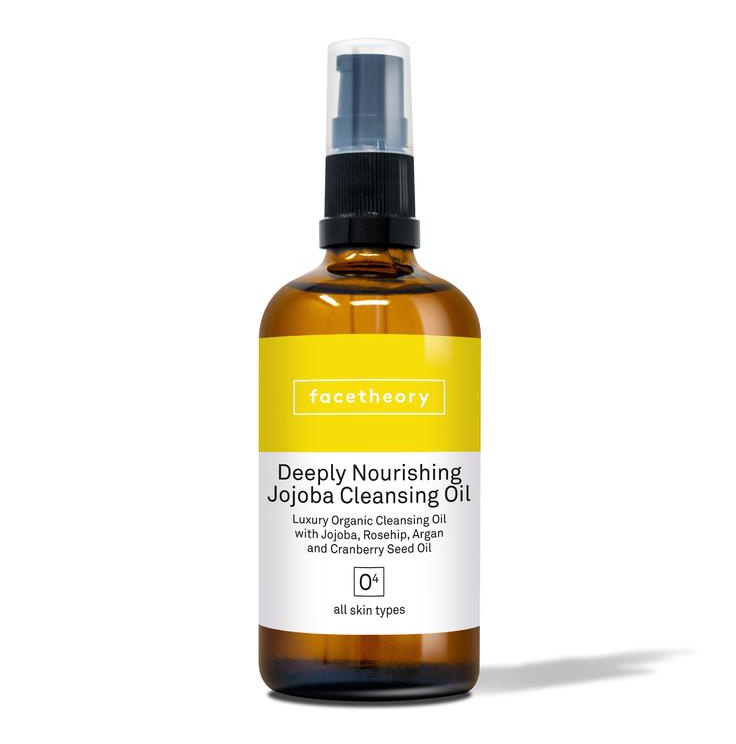
Deeply Nourishing Jojoba Cleansing Oil O4
Highlights
Skim through
| Ingredient name | what-it-does | irr., com. | ID-Rating |
|---|---|---|---|
| Simmondsia Chinensis (Jojoba) Seed Oil (Organic) | emollient | 0, 0-2 | goodie |
| Argania Spinosa (Argan) Oil (Organic) | antioxidant, emollient | goodie | |
| Rosa Canina (Rosehip) Fruit Oil (Organic) | emollient | ||
| Vaccinium Macrocarpon (Cranberry) Seed Oil | emollient | goodie | |
| Polyglyceryl-4 Oleate | emulsifying | ||
| Tocopherol (1% Naturally Derived) | antioxidant | 0-3, 0-3 | goodie |
facetheory Deeply Nourishing Jojoba Cleansing Oil O4Ingredients explained
Jojoba is a drought resistant evergreen shrub native to South-western North America. It's known and grown for jojoba oil, the golden yellow liquid coming from the seeds (about 50% of the weight of the seeds will be oil).
At first glance, it seems like your average emollient plant oil: it looks like an oil and it's nourishing and moisturizing to the skin but if we dig a bit deeper, it turns out that jojoba oil is really special and unique: technically - or rather chemically - it's not an oil but a wax ester (and calling it an oil is kind of sloppy).
When it comes to cosmetic oils and hype, argan oil is for sure leading the way. Dubbed as the "liquid gold of Morocco", we have to admit we have some trouble determining why this oil enjoys such a special miracle status. Not that it's not good, it is good, even great but reading the research about argan and a bunch of other plant oils we just do not see the big, unique differentiating factor (though that might be our fault not reading enough, obvs.)
So, argan oil comes from the kernel of the argan fruit that comes from the argan tree that grows only in Morocco. The tree is slow growing and getting the oil is a hard job. The traditional process is that the ripe argan fruits fall from the tree, then goats eat them up and poop out the seeds. The seeds are collected and smashed with a stone to get the kernels inside. This part is the hard one as the seeds have extremely hard shells. Once the kernels are obtained, the oil is pressed out from them (the kernels contain about 50% oil).
Though it says fruit oil in its name, the rosehip fruit contains the seeds that contain the oil. So this one is the same as Rosa Canina Seed Oil, or Rosehip Oil, known for its high omega fatty acid content (linoleic acid - 51%, linolenic acid - 19% and oleic acid - 20%) and skin-regenerative properties.
There is a common misconception that rosehip oil contains vitamin C as the fruit itself does, but vitamin C is a water-soluble vitamin hence it is not contained in the oil. The antioxidant and regenerative properties of the oil probably come from the oil-soluble tocopherols (vitamin E) and carotenoids (pro-vitamin A). Read more here.
A yellow-greenish oil coming from the seeds of Cranberry. Similar to other emollient plant oils, it is loaded with nice fatty acids. It contains a very balanced 1:1 ratio of anti-inflammatory omega-3 (aka linolenic acid) and barrier repairing omega-6 (aka linoleic acid) (30-38%), and also a decent amount of skin-nourishing omega-9, aka oleic acid. It also has high vitamin E content and significant antioxidant properties.
Other than being a nice emollient plant oil, we also found a research showing that cranberry oil has wound-healing potential.
- Primary fat-soluble antioxidant in our skin
- Significant photoprotection against UVB rays
- Vit C + Vit E work in synergy and provide great photoprotection
- Has emollient properties
- Easy to formulate, stable and relatively inexpensive
You may also want to take a look at...
| what‑it‑does | emollient |
| irritancy, com. | 0, 0-2 |
| what‑it‑does | antioxidant | emollient |
| what‑it‑does | emollient |
| what‑it‑does | emollient |
| what‑it‑does | emulsifying |
| what‑it‑does | antioxidant |
| irritancy, com. | 0-3, 0-3 |






 We don't have description for this ingredient yet.
We don't have description for this ingredient yet.